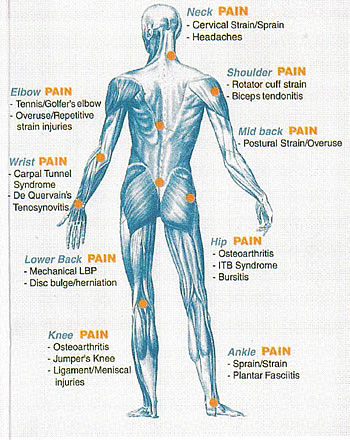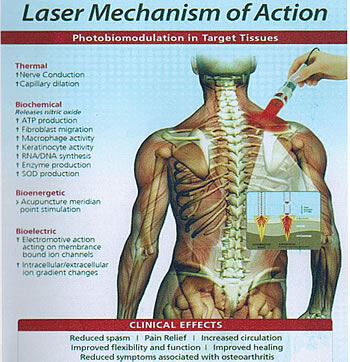 |
What is low level laser therapy? Low-level laser therapy is a regulative medical treatment used in specialties such as Dermatology, Traumatology, Sports Medicine, Orthopedics, Dental Medicine, Urology, Gynecology, General Orthopedics, Dental Medical, Chiropractic, Veterinary Medicine, Physical Therapy, Natural Medicine, etc. Over 2000 studies have established that such laser therapy is both effective and safe.People only think of lasers as cutting lasers. In order to cut with lasers, it is necessary to increase the power density (PD) to between 300 and 10,000 Watts per sq cm. Lasers do not even begin to feel warm unless the PD is 5 Watts per sq cm. In low-level laser therapy, the so-called cold laser therapy, the PD can be as low as 1 to 3 Milliwatts per sq cm.Low level lasers are used widely nowadays, in applications such as bar code checkout, laser printers, compact disc players and medical therapy.Laser therapy devices (using about 500 mW power output) do not have a thermal effect. This means that they provoke no immediate visible skin reactions or sensations during therapy. Low-level laser therapy is a soft therapy, without side effects. As against this, the surgical applications of laser have a different purpose and they therefore use much higher levels of power. |
 |
What does laser therapy do? One of the most important functions of low level laser therapy is to re-polarize sick and injured cellular membranes. This allows essential nutrients to transfer from the blood into the cell. Research has shown that low level laser therapy can increase cellular ATP (fuel) by as much as 150 %. Photobioactivation is a tern applied to a light stimulus that initiates or accelerates a physiological response. Other stimuli used in medicine are, for example, temperature, ultrasound, electrical power, electromagnetic fields, etc.Laser therapy was discovered in the 1960s. Today, thousands of clinical evaluations and over 100 double blind studies confirm its efficiency in:
Laser therapy is being used as a successful treatment option for countless pain, inflammation, dental, burn and illness conditions all over the world. Lasers have been used as therapeutic energy to bring about favourable biological effects in people, plants and animals. Unlike many therapies and drugs that just treat symptoms, laser therapy actually promotes and enhances healing. Laser therapy is the future of medicine and it is a modality that is rapidly growing in popularity. In USA, the FDA cleared multiple laser and LED devices for the treatment of a variety of medical conditions including carpal tunnel syndrome, cervical neck pain, low back pain, generalized muscle pain and for the acceleration of wound healing. Technical light therapy is being used by governmental agencies such as NASA for treating medical conditions in space applications. The US Olympic training facilities have released statements of endorsement of laser therapy for athletes. The growing acceptance of laser therapy in mainstream medicine is an indication of the medical efficacy of this treatment modality. It is not only a viable option, but often a superior treatment option.
|
Treatment parameters
There is no pain with laser treatment, and there are no known side effects. If pain increases marginally due to the treatment, it is an indication of tissue reactivity and this precedes the improvement. This is a sign that the laser therapy has increased the circulation and caused the release of toxins.
Patients need 10 to 12 sittings spread over 2 to 3 months. Each sitting is usually for only 2 to 3 minutes. The beneficial effects can begin to get noticed within 3 months.
Patients with acute conditions will frequently see beneficial effects almost immediately. Patients with chronic conditions may find that a slightly longer treatment regime is required before the effects begin to be obvious.
According to studies, the success rate is almost 80%, and the chances of the problem recurring are remote.






